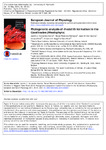Phylogenetic analysis of rhodolith formation in the Corallinales (Rhodophyta)
| dc.contributor.author | Hernández-Kantún, JJ | |
| dc.contributor.author | Riosmena-Rodriguez, R | |
| dc.contributor.author | Hall-Spencer, Jason | |
| dc.contributor.author | Peña, V | |
| dc.contributor.author | Maggs, CA | |
| dc.contributor.author | Rindi, F | |
| dc.date.accessioned | 2015-12-09T16:32:19Z | |
| dc.date.available | 2015-12-09T16:32:19Z | |
| dc.date.issued | 2015-01-02 | |
| dc.identifier.issn | 0967-0262 | |
| dc.identifier.issn | 1469-4433 | |
| dc.identifier.uri | http://hdl.handle.net/10026.1/3903 | |
| dc.description.abstract |
Although the ecological importance of rhodolith (maerl, free-living coralline algae) beds is well-known, rhodolith-forming species have been neglected in molecular phylogenetic studies. This is the first molecular systematic study aimed at understanding whether the rhodolith habit is a fixed feature in lineages and determining the relationship (phylogenetic vs. environmental) between rhodolith and crustose habits. Phylogenetic relationships of rhodolith-forming species and encrusting coralline algae at generic and species levels were analysed using SSU rDNA and psbA sequences. Extensive sampling in the European North Atlantic, Pacific and Caribbean Mexico of Phymatolithon, Lithothamnion, Lithophyllum and Neogoniolithon taxa forming rhodoliths and crusts was accompanied by examination of type or topotype material. Phylogenetic reconstruction showed that Neogoniolithon contained a monophyletic group of rhodolith-forming species whereas other rhodolith-formers were closely related to encrusting forms in the genera Phymatolithon, Lithothamnion, Mesophyllum, Hydrolithon, Spongites and Sporolithon. DNA analysis showed that the crust-forming Lithophyllum cf. incrustans/dentatum also forms rhodoliths with a stone nucleus that occur on rocky shores. In contrast, species that form beds of non-nucleate rhodoliths (e.g. Neogoniolithon spectabile, N. strictum, Lithophyllum cf. incrustans/dentatum or sp. 1 and Phymatolithon calcareum) rarely form crusts. The rhodolith habit cannot be used to delimit species for taxonomic or identification purposes. Extensive taxonomic revision will be required to deal with problems such as the position of specimens identified as Lithophyllum margaritae in two unrelated lineages. | |
| dc.format.extent | 46-61 | |
| dc.language | en | |
| dc.language.iso | en | |
| dc.publisher | Informa UK Limited | |
| dc.subject | cryptic species | |
| dc.subject | Lithophyllum | |
| dc.subject | maerl | |
| dc.subject | Phymatolithon | |
| dc.subject | psbA | |
| dc.subject | rhodolith | |
| dc.subject | SSU rDNA | |
| dc.subject | synapomorphy | |
| dc.title | Phylogenetic analysis of rhodolith formation in the Corallinales (Rhodophyta) | |
| dc.type | journal-article | |
| dc.type | Journal Article | |
| plymouth.author-url | https://www.webofscience.com/api/gateway?GWVersion=2&SrcApp=PARTNER_APP&SrcAuth=LinksAMR&KeyUT=WOS:000349385600004&DestLinkType=FullRecord&DestApp=ALL_WOS&UsrCustomerID=11bb513d99f797142bcfeffcc58ea008 | |
| plymouth.issue | 1 | |
| plymouth.volume | 50 | |
| plymouth.publication-status | Published | |
| plymouth.journal | European Journal of Phycology | |
| dc.identifier.doi | 10.1080/09670262.2014.984347 | |
| plymouth.organisational-group | /Plymouth | |
| plymouth.organisational-group | /Plymouth/Faculty of Science and Engineering | |
| plymouth.organisational-group | /Plymouth/Faculty of Science and Engineering/School of Biological and Marine Sciences | |
| plymouth.organisational-group | /Plymouth/PRIMaRE Publications | |
| plymouth.organisational-group | /Plymouth/REF 2021 Researchers by UoA | |
| plymouth.organisational-group | /Plymouth/REF 2021 Researchers by UoA/UoA07 Earth Systems and Environmental Sciences | |
| plymouth.organisational-group | /Plymouth/Research Groups | |
| plymouth.organisational-group | /Plymouth/Research Groups/Marine Institute | |
| plymouth.organisational-group | /Plymouth/Users by role | |
| plymouth.organisational-group | /Plymouth/Users by role/Academics | |
| dc.identifier.eissn | 1469-4433 | |
| dc.rights.embargoperiod | Not known | |
| rioxxterms.versionofrecord | 10.1080/09670262.2014.984347 | |
| rioxxterms.licenseref.uri | http://www.rioxx.net/licenses/all-rights-reserved | |
| rioxxterms.type | Journal Article/Review |


